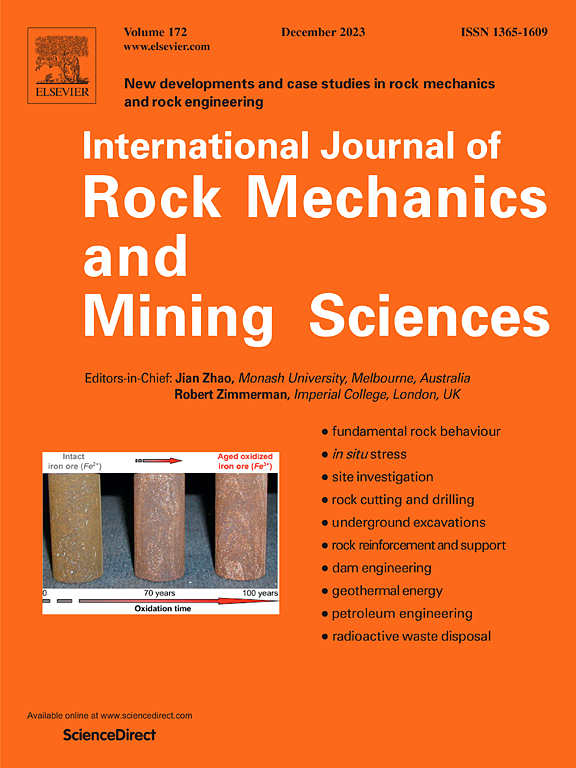Inference of the preferred direction of fractures in the universal elliptical disc model based on multiple borehole information
IF 7.5
1区 工程技术
Q1 ENGINEERING, GEOLOGICAL
International Journal of Rock Mechanics and Mining Sciences
Pub Date : 2025-06-02
DOI:10.1016/j.ijrmms.2025.106171
引用次数: 0
Abstract
Obtaining the preferred direction of fractures is helpful for reconstructing the stress state of rock mass and assessing its engineering geological properties. However, most fractures are buried within the rock mass, and we could not directly obtain the preferred direction. Instead, we can infer it based on fracture information related to the preferred direction that is exposed on rock outcrops or within boreholes. To describe the preferred direction of fractures, the universal elliptical disc (UED) model is introduced, characterized by its orientation and rotation angle. In this study, we infer the preferred direction of fractures in the UED model based on the fracture information intersecting with the borehole. Among them, the inference of the orientation is relatively mature and can be interpreted through the trace formed by intersecting with the borehole wall, while the inference of the rotation angle is the focus of this paper. To infer the rotation angle, the mathematical relationship between the geometric parameters of the UED model and the number of borehole intersections is first established. Subsequently, an optimization function is constructed using Monte Carlo simulation integration, and a genetic algorithm-based method for inferring the mean rotation angle is proposed. A hypothetical case is designed to validate the effectiveness of the proposed method. The proposed method is applied to determine the preferred direction of the mining-induced fractures in the Ji14-31050 mining face of Pingdingshan Coal Mine No. 10 in China. Moreover, the successful inference of rotation angle based on borehole information also provides a reference for inferring other parameters of the UED model and further summarizes the combination of borehole and outcrop numbers required to infer all geometric parameters of the UED model.
基于多井眼信息的通用椭圆盘模型裂缝优选方向推断
获得裂隙的优选方向有助于重建岩体的应力状态和评价其工程地质性质。然而,大多数裂缝都埋在岩体内部,我们无法直接获得优选方向。相反,我们可以根据与岩石露头或钻孔内暴露的优选方向相关的裂缝信息来推断。为了描述裂缝的优选方向,引入了通用椭圆盘(UED)模型,该模型以其方向和旋转角度为特征。在本研究中,我们根据与井眼相交的裂缝信息,推断出UED模型中裂缝的优选方向。其中,方位推断相对成熟,可以通过与井壁相交形成的迹线进行解释,而旋转角度推断是本文的重点。为了推断旋转角度,首先建立了UED模型几何参数与井眼相交数之间的数学关系。随后,利用蒙特卡罗模拟积分构造了优化函数,并提出了一种基于遗传算法的平均旋转角度推断方法。设计了一个假设案例来验证所提出方法的有效性。将该方法应用于平顶山十矿Ji14-31050工作面采动裂隙优选方向的确定。此外,根据钻孔信息成功推断出的旋转角度也为推断UED模型的其他参数提供了参考,并进一步总结了推断UED模型所有几何参数所需的钻孔数和露头数组合。
本文章由计算机程序翻译,如有差异,请以英文原文为准。
求助全文
约1分钟内获得全文
求助全文
来源期刊
CiteScore
14.00
自引率
5.60%
发文量
196
审稿时长
18 weeks
期刊介绍:
The International Journal of Rock Mechanics and Mining Sciences focuses on original research, new developments, site measurements, and case studies within the fields of rock mechanics and rock engineering. Serving as an international platform, it showcases high-quality papers addressing rock mechanics and the application of its principles and techniques in mining and civil engineering projects situated on or within rock masses. These projects encompass a wide range, including slopes, open-pit mines, quarries, shafts, tunnels, caverns, underground mines, metro systems, dams, hydro-electric stations, geothermal energy, petroleum engineering, and radioactive waste disposal. The journal welcomes submissions on various topics, with particular interest in theoretical advancements, analytical and numerical methods, rock testing, site investigation, and case studies.

 求助内容:
求助内容: 应助结果提醒方式:
应助结果提醒方式:


